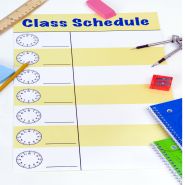Active Learning has been defined in a number of different ways, varying from specialism to specialism. It has been related to several well-known educational theories and is based on research.
So what is it?
In essence, it is the theory that we learn by doing. It was defined by Bonwell and Eison (1991) as being ‘anything that involves students in doing things and thinking about the things they are doing’.
There are many methods of doing this: collaborative learning; role-play; making things; reflective discussions. There are concepts such as the TASC wheel and the Critical Skills methodology. What is lacking in many journals is an outline of simple but effective methods that can be used across the curriculum on a day in, day out basis. Ideas that engage and increase understanding, whilst acknowledging the potential problems associated with any teaching and learning style.
Here is a selection of exercises that incorporate Active Learning:
1. Living Graphs
Graphs are used in lots of subjects. They can be very hard to understand. One way of improving understanding is to create a large graph on the floor; in a large space if available. Pupils can be given tabards that relate to different elements of the graph.
As the teacher explains how the graph ‘works’ the pupil with the relevant tabard physically moves to the correct point on the graph. Where there are changes on the graph, for example in Geography where rainfall is being analysed, factor tabards can be added. The pupils with the factor tabards can then ‘move’ the next point on the graph into position. This involves learners in the development of the graph; allows interaction with the graph and provides plenty of opportunities to discuss and differentiate.
2. Kinaesthetic Sequencing/Matching
Sequencing and matching exercises are used across the curriculum. Typically, they involve cutting out and sticking in a book. Some pupils clearly understand, some have guessed, some copy and the teacher cannot always identify who is and isn’t comprehending the task.
A simple solution is to print out all of the relevant things that are going to be sequenced or matched on sheets of A4, in a font size that can be read from anywhere in the room. Hand the sheets to pupils and ask them to think about what is on the sheet. Pupils then say to the class what their statement is and what they think it means. Immediately, any misunderstanding is identified and can be addressed.
Learners then match themselves with the correct ‘opposite’ or arrange themselves into the correct sequence. For a matching exercise the pair can discuss why they match and explain this to the class. In Languages, for example, this could be as simple as a word and its equivalent in English. For sequencing tasks this could be explaining why things have to go in this particular order.
3. Jumbled Sentences/Paragraphs/Essays
Developing an understanding of how to write effectively, at any level, is difficult. Break down a section of text into chunks and place these on cards to give to your pupils. Next, pupils move themselves into the order in which they think is correct. This is a simple way of developing sentence level understanding.
This task can be developed beyond sentences into paragraphs by simply having that method replicated for the relevant number of sentences. Pupils then move their sentences into the order that they think makes up the paragraph.
To extend this and make it more challenging, leave some components blank and ask the pupils to devise their own sentences to fill the gaps in the relevant sections: this works particularly well at GCSE and A level when developing essay-writing skills.
4. Marketplace
This is a reasonably well known method. With topics that have a number of categories, split the class into groups based on those categories. Each group researches the topic and prepares a short presentation. Once completed members of each group visit each of the other groups to see/hear their presentation. They take notes and return to their group.
The information can then be combined to provide a full understanding of the topic. The findings can be used for a larger presentation, mind maps etc. This activity places pupils at the centre of their learning and provides lots of opportunities for discussion, reflection and differentiation.
5. ‘Speed Dating’ (really!)
Where there are numerous relationships between items, factors, causes etc. in a topic it is possible to utilise this method. Pupils are given cards describing their features: for example, in science it could be their physical properties.
They then move around on a carousel basis with a one/two-minute ‘speed date’ in which they discuss their relationship potential: similarities, differences etc. This approach works well in a number of contexts, for example, as a revision in a History lesson.









